Leadership in Organizations: Styles, Culture, and Teamwork Report
VerifiedAdded on 2022/09/10
|14
|4341
|21
Report
AI Summary
This report delves into the multifaceted aspects of leadership, exploring how organizational culture, legal, regulatory, and ethical requirements influence leadership demands. It examines the impact of social concerns and expectations on leadership within organizations, using examples like Nike's adjustments to address social issues. The report differentiates between management and leadership, evaluating various leadership styles such as autocratic, democratic, and laissez-faire, and discussing the importance of adapting styles to different situations. It further analyzes the skills needed to foster team involvement, professionalism, mutual trust, respect, and support. The report emphasizes the role of leaders in creating a culture that promotes these values, ensuring team objectives are met, and fostering a positive work environment.
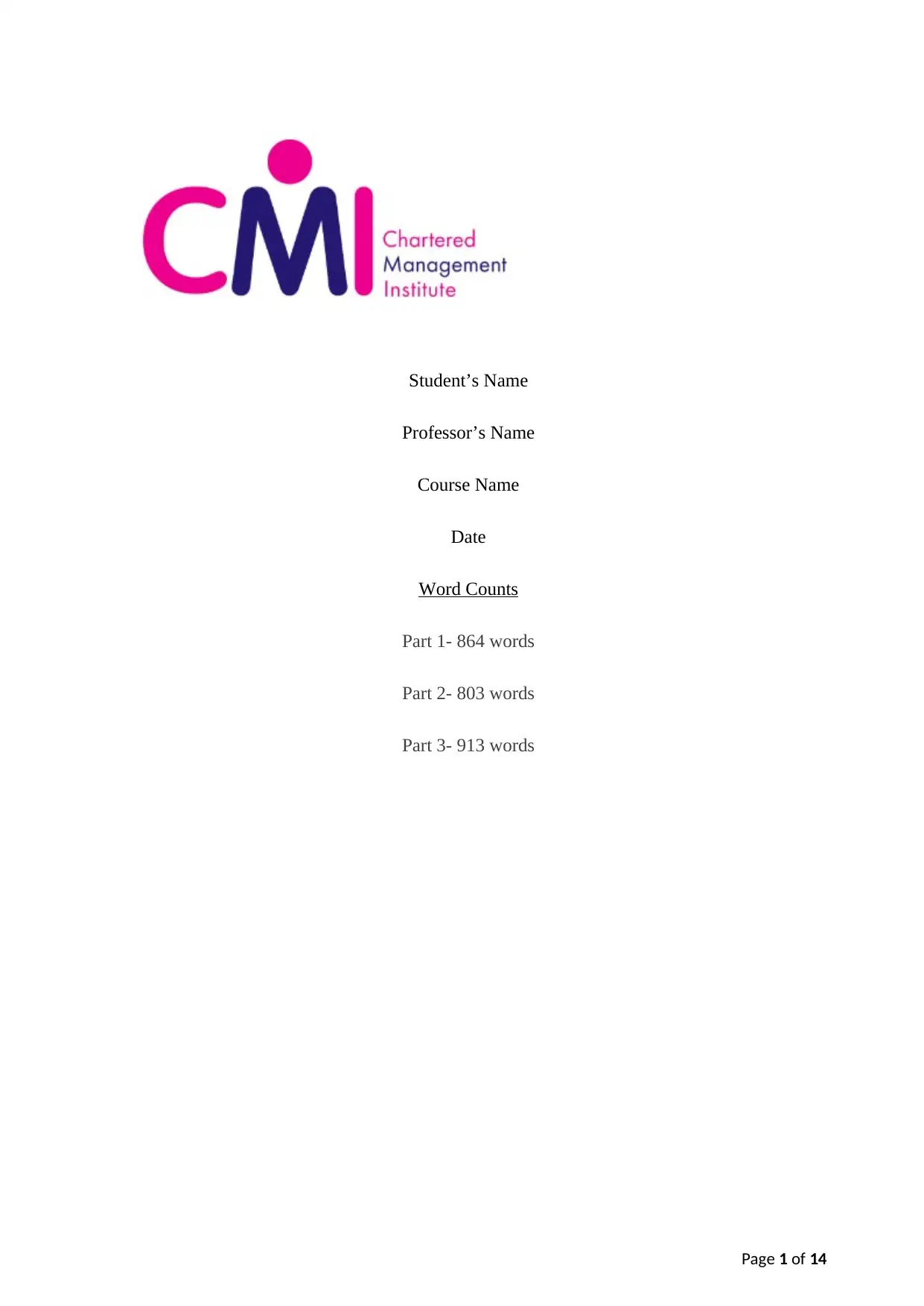
Student’s Name
Professor’s Name
Course Name
Date
Word Counts
Part 1- 864 words
Part 2- 803 words
Part 3- 913 words
Page 1 of 14
Professor’s Name
Course Name
Date
Word Counts
Part 1- 864 words
Part 2- 803 words
Part 3- 913 words
Page 1 of 14
Paraphrase This Document
Need a fresh take? Get an instant paraphrase of this document with our AI Paraphraser
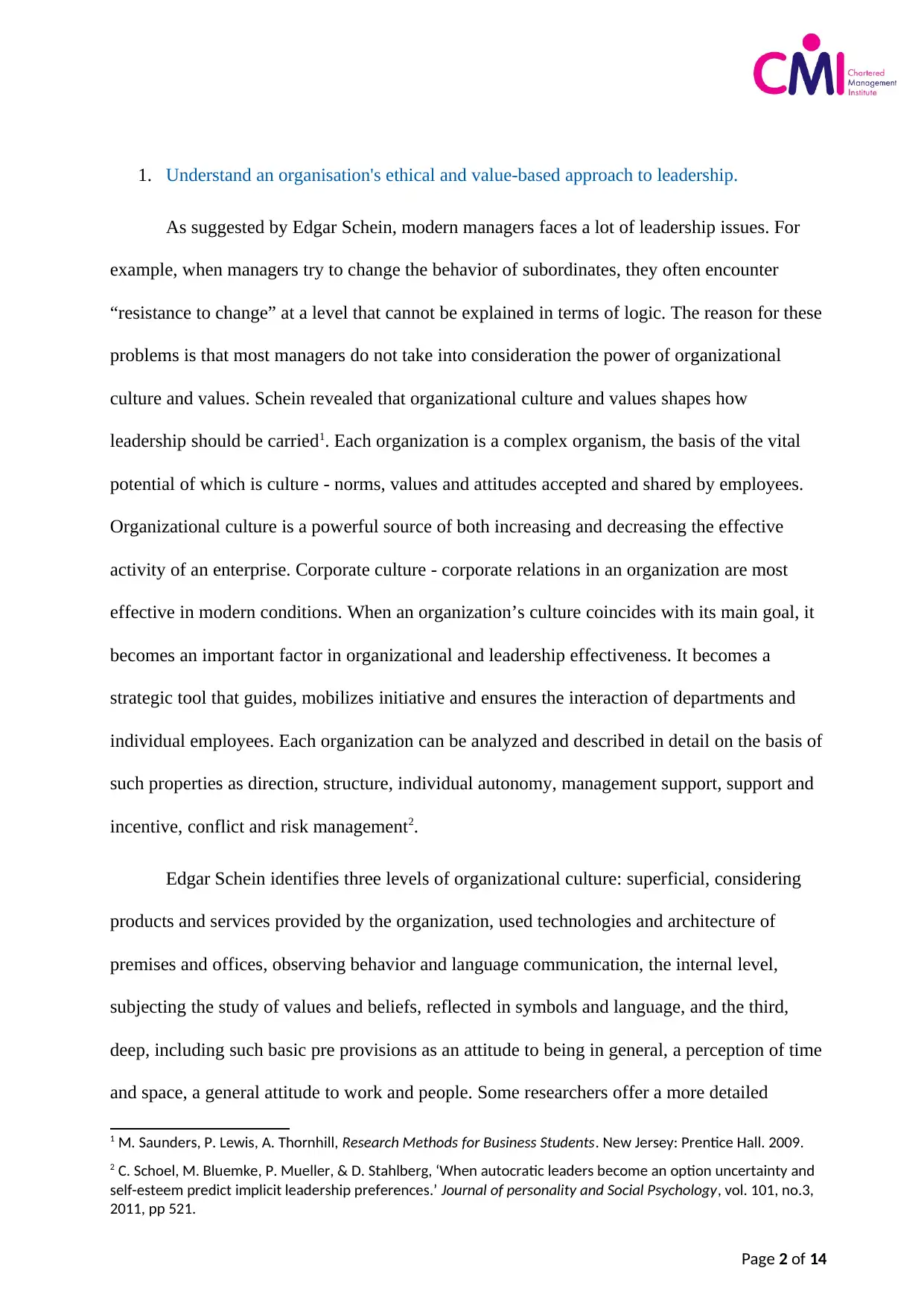
1. Understand an organisation's ethical and value-based approach to leadership.
As suggested by Edgar Schein, modern managers faces a lot of leadership issues. For
example, when managers try to change the behavior of subordinates, they often encounter
“resistance to change” at a level that cannot be explained in terms of logic. The reason for these
problems is that most managers do not take into consideration the power of organizational
culture and values. Schein revealed that organizational culture and values shapes how
leadership should be carried1. Each organization is a complex organism, the basis of the vital
potential of which is culture - norms, values and attitudes accepted and shared by employees.
Organizational culture is a powerful source of both increasing and decreasing the effective
activity of an enterprise. Corporate culture - corporate relations in an organization are most
effective in modern conditions. When an organization’s culture coincides with its main goal, it
becomes an important factor in organizational and leadership effectiveness. It becomes a
strategic tool that guides, mobilizes initiative and ensures the interaction of departments and
individual employees. Each organization can be analyzed and described in detail on the basis of
such properties as direction, structure, individual autonomy, management support, support and
incentive, conflict and risk management2.
Edgar Schein identifies three levels of organizational culture: superficial, considering
products and services provided by the organization, used technologies and architecture of
premises and offices, observing behavior and language communication, the internal level,
subjecting the study of values and beliefs, reflected in symbols and language, and the third,
deep, including such basic pre provisions as an attitude to being in general, a perception of time
and space, a general attitude to work and people. Some researchers offer a more detailed
1 M. Saunders, P. Lewis, A. Thornhill, Research Methods for Business Students. New Jersey: Prentice Hall. 2009.
2 C. Schoel, M. Bluemke, P. Mueller, & D. Stahlberg, ‘When autocratic leaders become an option uncertainty and
self-esteem predict implicit leadership preferences.’ Journal of personality and Social Psychology, vol. 101, no.3,
2011, pp 521.
Page 2 of 14
As suggested by Edgar Schein, modern managers faces a lot of leadership issues. For
example, when managers try to change the behavior of subordinates, they often encounter
“resistance to change” at a level that cannot be explained in terms of logic. The reason for these
problems is that most managers do not take into consideration the power of organizational
culture and values. Schein revealed that organizational culture and values shapes how
leadership should be carried1. Each organization is a complex organism, the basis of the vital
potential of which is culture - norms, values and attitudes accepted and shared by employees.
Organizational culture is a powerful source of both increasing and decreasing the effective
activity of an enterprise. Corporate culture - corporate relations in an organization are most
effective in modern conditions. When an organization’s culture coincides with its main goal, it
becomes an important factor in organizational and leadership effectiveness. It becomes a
strategic tool that guides, mobilizes initiative and ensures the interaction of departments and
individual employees. Each organization can be analyzed and described in detail on the basis of
such properties as direction, structure, individual autonomy, management support, support and
incentive, conflict and risk management2.
Edgar Schein identifies three levels of organizational culture: superficial, considering
products and services provided by the organization, used technologies and architecture of
premises and offices, observing behavior and language communication, the internal level,
subjecting the study of values and beliefs, reflected in symbols and language, and the third,
deep, including such basic pre provisions as an attitude to being in general, a perception of time
and space, a general attitude to work and people. Some researchers offer a more detailed
1 M. Saunders, P. Lewis, A. Thornhill, Research Methods for Business Students. New Jersey: Prentice Hall. 2009.
2 C. Schoel, M. Bluemke, P. Mueller, & D. Stahlberg, ‘When autocratic leaders become an option uncertainty and
self-esteem predict implicit leadership preferences.’ Journal of personality and Social Psychology, vol. 101, no.3,
2011, pp 521.
Page 2 of 14
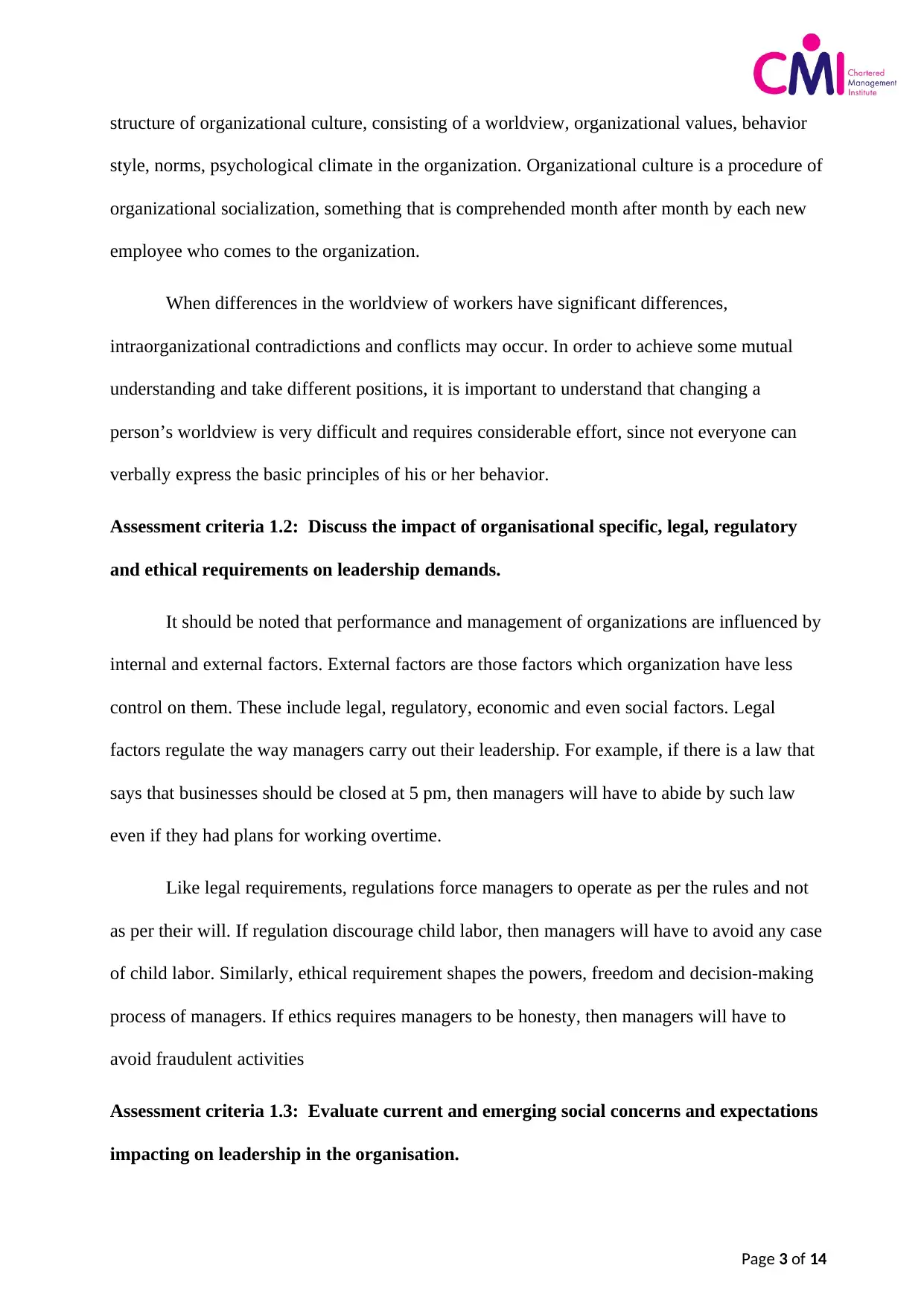
structure of organizational culture, consisting of a worldview, organizational values, behavior
style, norms, psychological climate in the organization. Organizational culture is a procedure of
organizational socialization, something that is comprehended month after month by each new
employee who comes to the organization.
When differences in the worldview of workers have significant differences,
intraorganizational contradictions and conflicts may occur. In order to achieve some mutual
understanding and take different positions, it is important to understand that changing a
person’s worldview is very difficult and requires considerable effort, since not everyone can
verbally express the basic principles of his or her behavior.
Assessment criteria 1.2: Discuss the impact of organisational specific, legal, regulatory
and ethical requirements on leadership demands.
It should be noted that performance and management of organizations are influenced by
internal and external factors. External factors are those factors which organization have less
control on them. These include legal, regulatory, economic and even social factors. Legal
factors regulate the way managers carry out their leadership. For example, if there is a law that
says that businesses should be closed at 5 pm, then managers will have to abide by such law
even if they had plans for working overtime.
Like legal requirements, regulations force managers to operate as per the rules and not
as per their will. If regulation discourage child labor, then managers will have to avoid any case
of child labor. Similarly, ethical requirement shapes the powers, freedom and decision-making
process of managers. If ethics requires managers to be honesty, then managers will have to
avoid fraudulent activities
Assessment criteria 1.3: Evaluate current and emerging social concerns and expectations
impacting on leadership in the organisation.
Page 3 of 14
style, norms, psychological climate in the organization. Organizational culture is a procedure of
organizational socialization, something that is comprehended month after month by each new
employee who comes to the organization.
When differences in the worldview of workers have significant differences,
intraorganizational contradictions and conflicts may occur. In order to achieve some mutual
understanding and take different positions, it is important to understand that changing a
person’s worldview is very difficult and requires considerable effort, since not everyone can
verbally express the basic principles of his or her behavior.
Assessment criteria 1.2: Discuss the impact of organisational specific, legal, regulatory
and ethical requirements on leadership demands.
It should be noted that performance and management of organizations are influenced by
internal and external factors. External factors are those factors which organization have less
control on them. These include legal, regulatory, economic and even social factors. Legal
factors regulate the way managers carry out their leadership. For example, if there is a law that
says that businesses should be closed at 5 pm, then managers will have to abide by such law
even if they had plans for working overtime.
Like legal requirements, regulations force managers to operate as per the rules and not
as per their will. If regulation discourage child labor, then managers will have to avoid any case
of child labor. Similarly, ethical requirement shapes the powers, freedom and decision-making
process of managers. If ethics requires managers to be honesty, then managers will have to
avoid fraudulent activities
Assessment criteria 1.3: Evaluate current and emerging social concerns and expectations
impacting on leadership in the organisation.
Page 3 of 14
⊘ This is a preview!⊘
Do you want full access?
Subscribe today to unlock all pages.

Trusted by 1+ million students worldwide
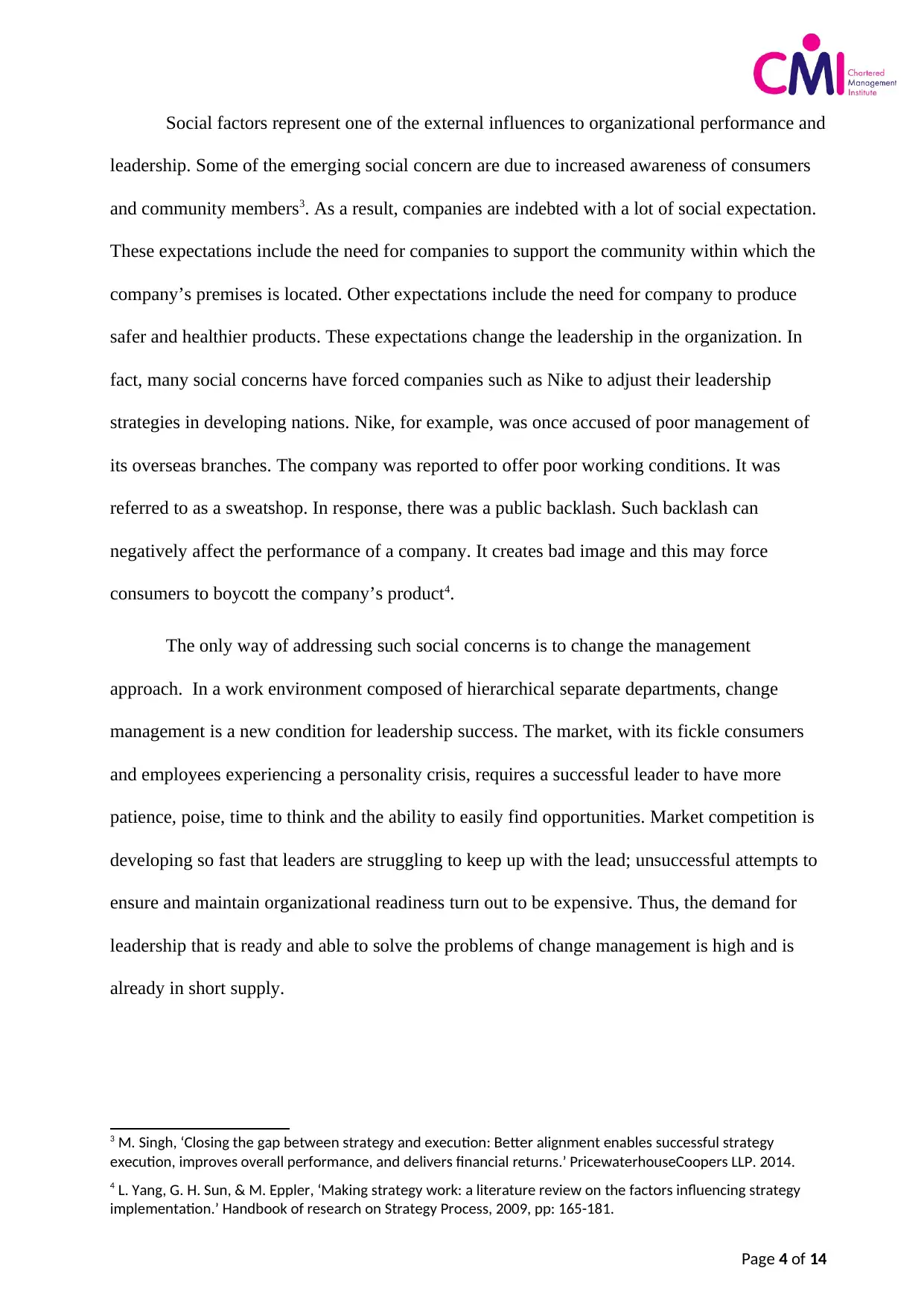
Social factors represent one of the external influences to organizational performance and
leadership. Some of the emerging social concern are due to increased awareness of consumers
and community members3. As a result, companies are indebted with a lot of social expectation.
These expectations include the need for companies to support the community within which the
company’s premises is located. Other expectations include the need for company to produce
safer and healthier products. These expectations change the leadership in the organization. In
fact, many social concerns have forced companies such as Nike to adjust their leadership
strategies in developing nations. Nike, for example, was once accused of poor management of
its overseas branches. The company was reported to offer poor working conditions. It was
referred to as a sweatshop. In response, there was a public backlash. Such backlash can
negatively affect the performance of a company. It creates bad image and this may force
consumers to boycott the company’s product4.
The only way of addressing such social concerns is to change the management
approach. In a work environment composed of hierarchical separate departments, change
management is a new condition for leadership success. The market, with its fickle consumers
and employees experiencing a personality crisis, requires a successful leader to have more
patience, poise, time to think and the ability to easily find opportunities. Market competition is
developing so fast that leaders are struggling to keep up with the lead; unsuccessful attempts to
ensure and maintain organizational readiness turn out to be expensive. Thus, the demand for
leadership that is ready and able to solve the problems of change management is high and is
already in short supply.
3 M. Singh, ‘Closing the gap between strategy and execution: Better alignment enables successful strategy
execution, improves overall performance, and delivers financial returns.’ PricewaterhouseCoopers LLP. 2014.
4 L. Yang, G. H. Sun, & M. Eppler, ‘Making strategy work: a literature review on the factors influencing strategy
implementation.’ Handbook of research on Strategy Process, 2009, pp: 165-181.
Page 4 of 14
leadership. Some of the emerging social concern are due to increased awareness of consumers
and community members3. As a result, companies are indebted with a lot of social expectation.
These expectations include the need for companies to support the community within which the
company’s premises is located. Other expectations include the need for company to produce
safer and healthier products. These expectations change the leadership in the organization. In
fact, many social concerns have forced companies such as Nike to adjust their leadership
strategies in developing nations. Nike, for example, was once accused of poor management of
its overseas branches. The company was reported to offer poor working conditions. It was
referred to as a sweatshop. In response, there was a public backlash. Such backlash can
negatively affect the performance of a company. It creates bad image and this may force
consumers to boycott the company’s product4.
The only way of addressing such social concerns is to change the management
approach. In a work environment composed of hierarchical separate departments, change
management is a new condition for leadership success. The market, with its fickle consumers
and employees experiencing a personality crisis, requires a successful leader to have more
patience, poise, time to think and the ability to easily find opportunities. Market competition is
developing so fast that leaders are struggling to keep up with the lead; unsuccessful attempts to
ensure and maintain organizational readiness turn out to be expensive. Thus, the demand for
leadership that is ready and able to solve the problems of change management is high and is
already in short supply.
3 M. Singh, ‘Closing the gap between strategy and execution: Better alignment enables successful strategy
execution, improves overall performance, and delivers financial returns.’ PricewaterhouseCoopers LLP. 2014.
4 L. Yang, G. H. Sun, & M. Eppler, ‘Making strategy work: a literature review on the factors influencing strategy
implementation.’ Handbook of research on Strategy Process, 2009, pp: 165-181.
Page 4 of 14
Paraphrase This Document
Need a fresh take? Get an instant paraphrase of this document with our AI Paraphraser
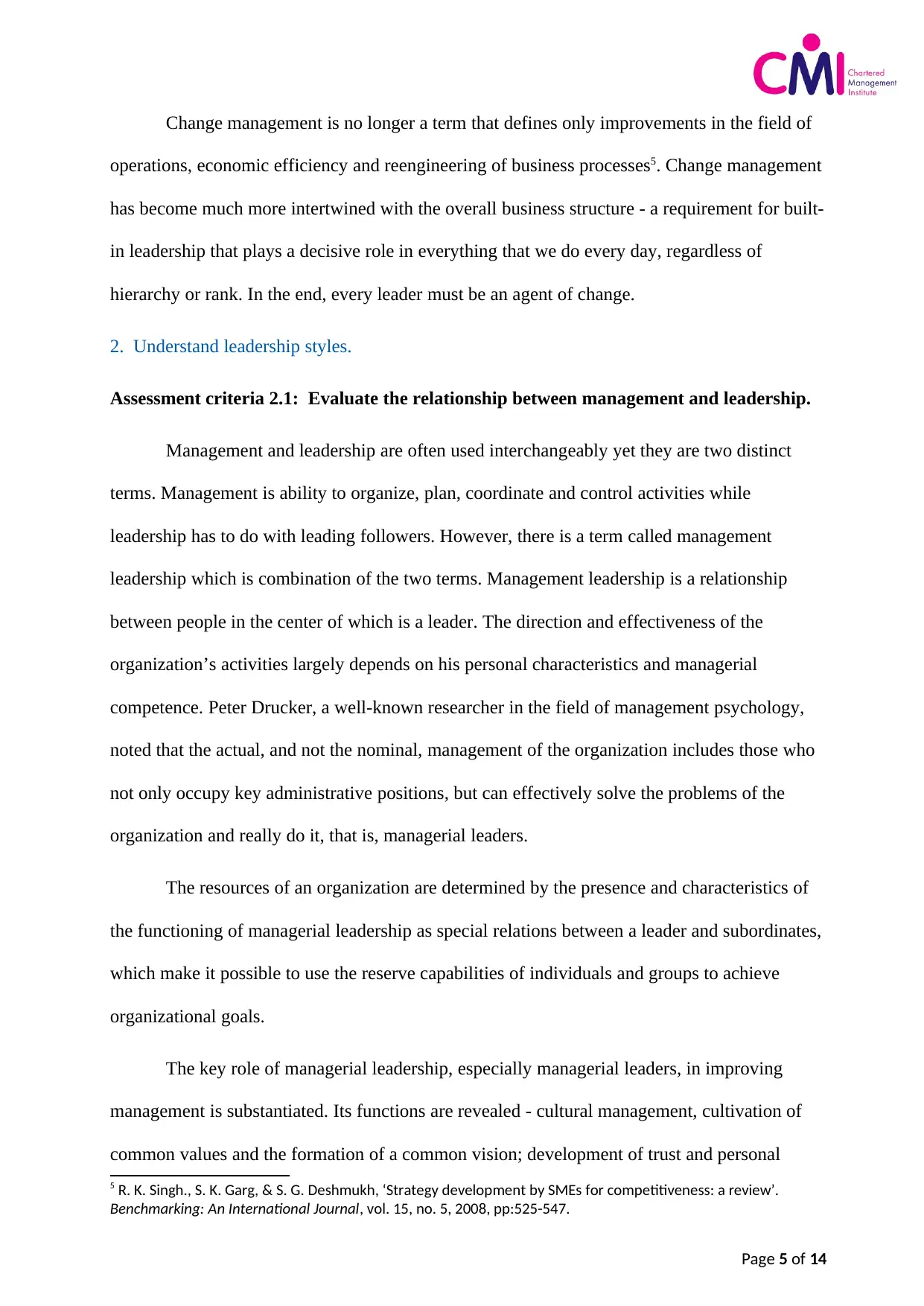
Change management is no longer a term that defines only improvements in the field of
operations, economic efficiency and reengineering of business processes5. Change management
has become much more intertwined with the overall business structure - a requirement for built-
in leadership that plays a decisive role in everything that we do every day, regardless of
hierarchy or rank. In the end, every leader must be an agent of change.
2. Understand leadership styles.
Assessment criteria 2.1: Evaluate the relationship between management and leadership.
Management and leadership are often used interchangeably yet they are two distinct
terms. Management is ability to organize, plan, coordinate and control activities while
leadership has to do with leading followers. However, there is a term called management
leadership which is combination of the two terms. Management leadership is a relationship
between people in the center of which is a leader. The direction and effectiveness of the
organization’s activities largely depends on his personal characteristics and managerial
competence. Peter Drucker, a well-known researcher in the field of management psychology,
noted that the actual, and not the nominal, management of the organization includes those who
not only occupy key administrative positions, but can effectively solve the problems of the
organization and really do it, that is, managerial leaders.
The resources of an organization are determined by the presence and characteristics of
the functioning of managerial leadership as special relations between a leader and subordinates,
which make it possible to use the reserve capabilities of individuals and groups to achieve
organizational goals.
The key role of managerial leadership, especially managerial leaders, in improving
management is substantiated. Its functions are revealed - cultural management, cultivation of
common values and the formation of a common vision; development of trust and personal
5 R. K. Singh., S. K. Garg, & S. G. Deshmukh, ‘Strategy development by SMEs for competitiveness: a review’.
Benchmarking: An International Journal, vol. 15, no. 5, 2008, pp:525-547.
Page 5 of 14
operations, economic efficiency and reengineering of business processes5. Change management
has become much more intertwined with the overall business structure - a requirement for built-
in leadership that plays a decisive role in everything that we do every day, regardless of
hierarchy or rank. In the end, every leader must be an agent of change.
2. Understand leadership styles.
Assessment criteria 2.1: Evaluate the relationship between management and leadership.
Management and leadership are often used interchangeably yet they are two distinct
terms. Management is ability to organize, plan, coordinate and control activities while
leadership has to do with leading followers. However, there is a term called management
leadership which is combination of the two terms. Management leadership is a relationship
between people in the center of which is a leader. The direction and effectiveness of the
organization’s activities largely depends on his personal characteristics and managerial
competence. Peter Drucker, a well-known researcher in the field of management psychology,
noted that the actual, and not the nominal, management of the organization includes those who
not only occupy key administrative positions, but can effectively solve the problems of the
organization and really do it, that is, managerial leaders.
The resources of an organization are determined by the presence and characteristics of
the functioning of managerial leadership as special relations between a leader and subordinates,
which make it possible to use the reserve capabilities of individuals and groups to achieve
organizational goals.
The key role of managerial leadership, especially managerial leaders, in improving
management is substantiated. Its functions are revealed - cultural management, cultivation of
common values and the formation of a common vision; development of trust and personal
5 R. K. Singh., S. K. Garg, & S. G. Deshmukh, ‘Strategy development by SMEs for competitiveness: a review’.
Benchmarking: An International Journal, vol. 15, no. 5, 2008, pp:525-547.
Page 5 of 14
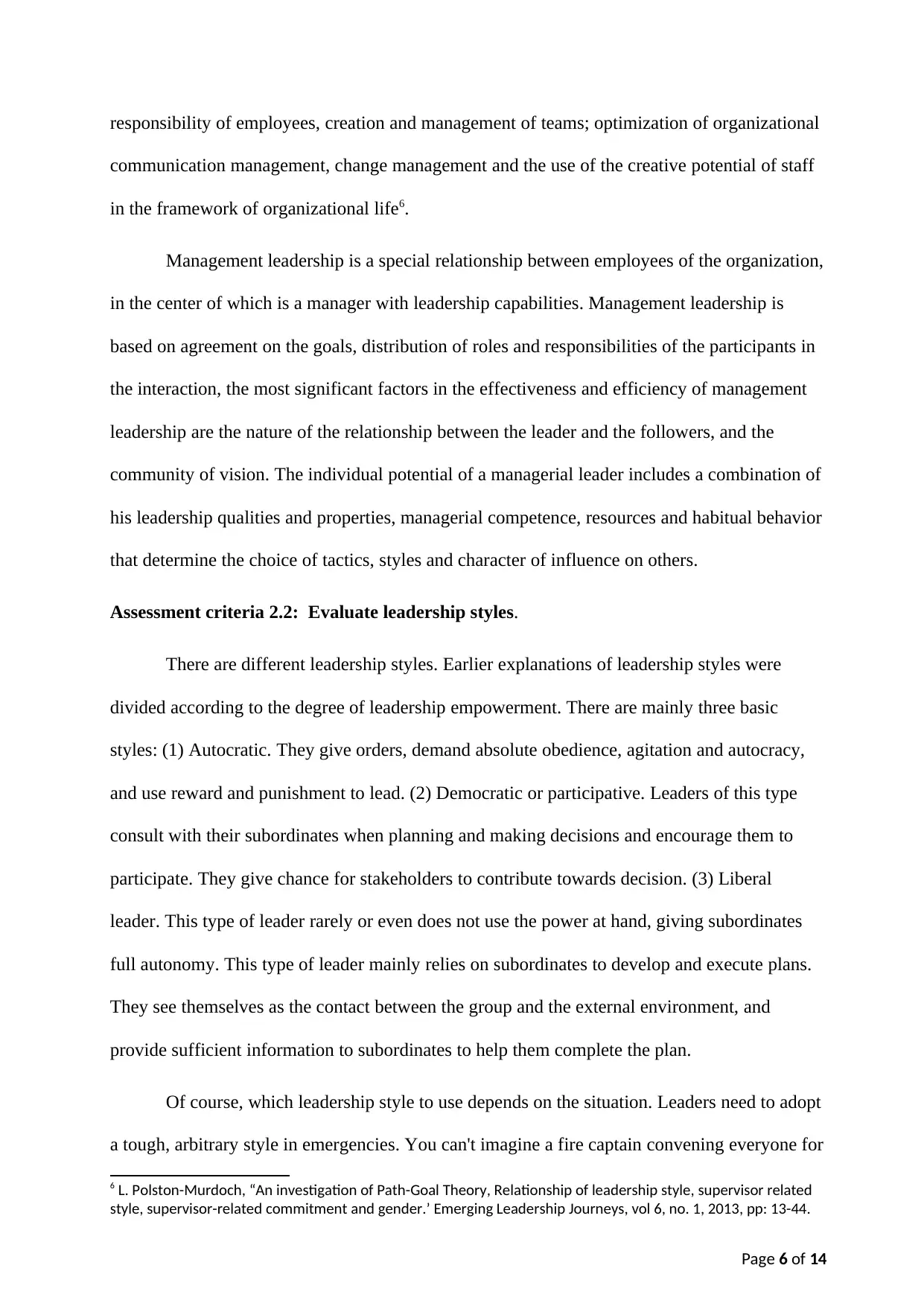
responsibility of employees, creation and management of teams; optimization of organizational
communication management, change management and the use of the creative potential of staff
in the framework of organizational life6.
Management leadership is a special relationship between employees of the organization,
in the center of which is a manager with leadership capabilities. Management leadership is
based on agreement on the goals, distribution of roles and responsibilities of the participants in
the interaction, the most significant factors in the effectiveness and efficiency of management
leadership are the nature of the relationship between the leader and the followers, and the
community of vision. The individual potential of a managerial leader includes a combination of
his leadership qualities and properties, managerial competence, resources and habitual behavior
that determine the choice of tactics, styles and character of influence on others.
Assessment criteria 2.2: Evaluate leadership styles.
There are different leadership styles. Earlier explanations of leadership styles were
divided according to the degree of leadership empowerment. There are mainly three basic
styles: (1) Autocratic. They give orders, demand absolute obedience, agitation and autocracy,
and use reward and punishment to lead. (2) Democratic or participative. Leaders of this type
consult with their subordinates when planning and making decisions and encourage them to
participate. They give chance for stakeholders to contribute towards decision. (3) Liberal
leader. This type of leader rarely or even does not use the power at hand, giving subordinates
full autonomy. This type of leader mainly relies on subordinates to develop and execute plans.
They see themselves as the contact between the group and the external environment, and
provide sufficient information to subordinates to help them complete the plan.
Of course, which leadership style to use depends on the situation. Leaders need to adopt
a tough, arbitrary style in emergencies. You can't imagine a fire captain convening everyone for
6 L. Polston-Murdoch, “An investigation of Path-Goal Theory, Relationship of leadership style, supervisor related
style, supervisor-related commitment and gender.’ Emerging Leadership Journeys, vol 6, no. 1, 2013, pp: 13-44.
Page 6 of 14
communication management, change management and the use of the creative potential of staff
in the framework of organizational life6.
Management leadership is a special relationship between employees of the organization,
in the center of which is a manager with leadership capabilities. Management leadership is
based on agreement on the goals, distribution of roles and responsibilities of the participants in
the interaction, the most significant factors in the effectiveness and efficiency of management
leadership are the nature of the relationship between the leader and the followers, and the
community of vision. The individual potential of a managerial leader includes a combination of
his leadership qualities and properties, managerial competence, resources and habitual behavior
that determine the choice of tactics, styles and character of influence on others.
Assessment criteria 2.2: Evaluate leadership styles.
There are different leadership styles. Earlier explanations of leadership styles were
divided according to the degree of leadership empowerment. There are mainly three basic
styles: (1) Autocratic. They give orders, demand absolute obedience, agitation and autocracy,
and use reward and punishment to lead. (2) Democratic or participative. Leaders of this type
consult with their subordinates when planning and making decisions and encourage them to
participate. They give chance for stakeholders to contribute towards decision. (3) Liberal
leader. This type of leader rarely or even does not use the power at hand, giving subordinates
full autonomy. This type of leader mainly relies on subordinates to develop and execute plans.
They see themselves as the contact between the group and the external environment, and
provide sufficient information to subordinates to help them complete the plan.
Of course, which leadership style to use depends on the situation. Leaders need to adopt
a tough, arbitrary style in emergencies. You can't imagine a fire captain convening everyone for
6 L. Polston-Murdoch, “An investigation of Path-Goal Theory, Relationship of leadership style, supervisor related
style, supervisor-related commitment and gender.’ Emerging Leadership Journeys, vol 6, no. 1, 2013, pp: 13-44.
Page 6 of 14
⊘ This is a preview!⊘
Do you want full access?
Subscribe today to unlock all pages.

Trusted by 1+ million students worldwide
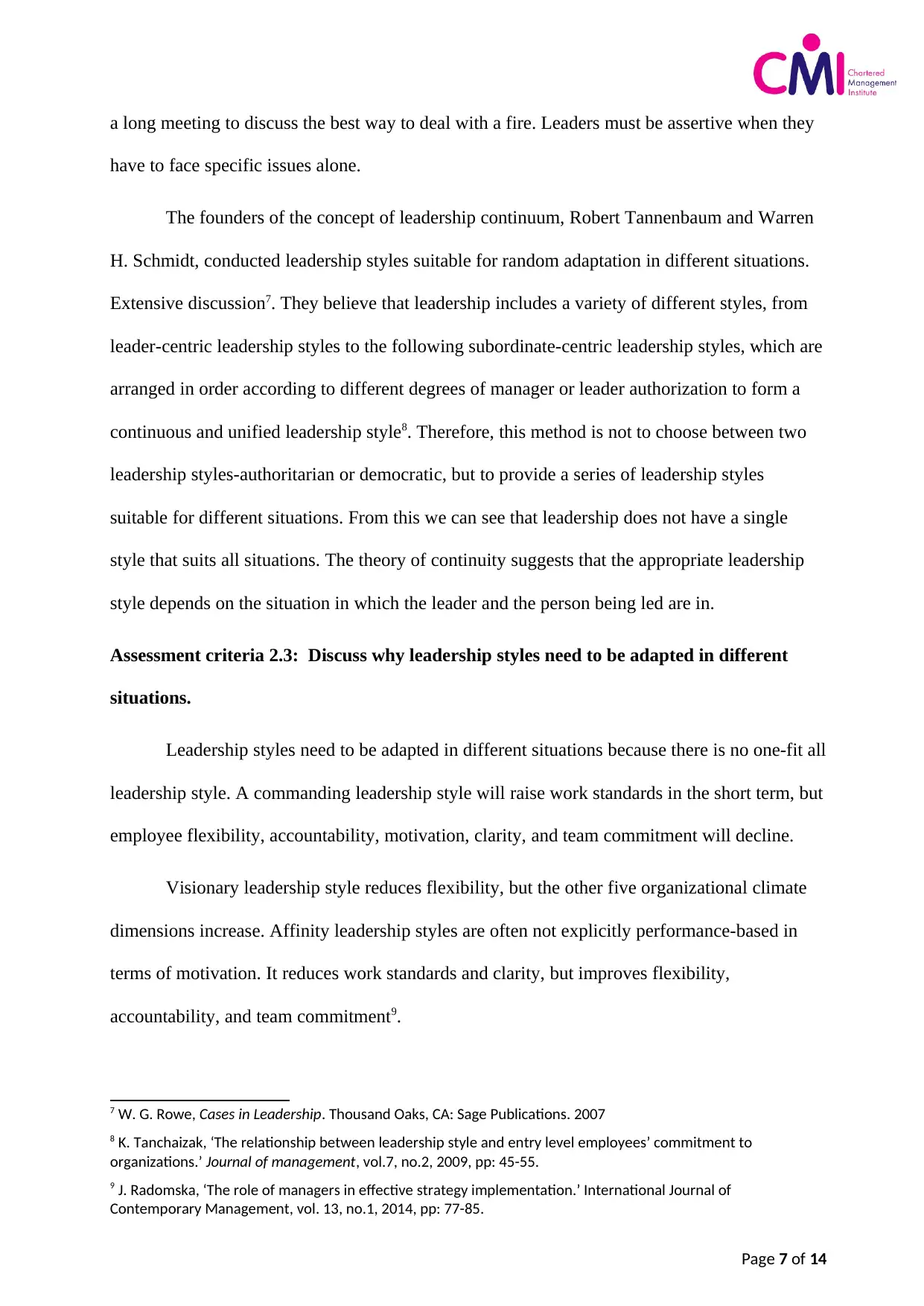
a long meeting to discuss the best way to deal with a fire. Leaders must be assertive when they
have to face specific issues alone.
The founders of the concept of leadership continuum, Robert Tannenbaum and Warren
H. Schmidt, conducted leadership styles suitable for random adaptation in different situations.
Extensive discussion7. They believe that leadership includes a variety of different styles, from
leader-centric leadership styles to the following subordinate-centric leadership styles, which are
arranged in order according to different degrees of manager or leader authorization to form a
continuous and unified leadership style8. Therefore, this method is not to choose between two
leadership styles-authoritarian or democratic, but to provide a series of leadership styles
suitable for different situations. From this we can see that leadership does not have a single
style that suits all situations. The theory of continuity suggests that the appropriate leadership
style depends on the situation in which the leader and the person being led are in.
Assessment criteria 2.3: Discuss why leadership styles need to be adapted in different
situations.
Leadership styles need to be adapted in different situations because there is no one-fit all
leadership style. A commanding leadership style will raise work standards in the short term, but
employee flexibility, accountability, motivation, clarity, and team commitment will decline.
Visionary leadership style reduces flexibility, but the other five organizational climate
dimensions increase. Affinity leadership styles are often not explicitly performance-based in
terms of motivation. It reduces work standards and clarity, but improves flexibility,
accountability, and team commitment9.
7 W. G. Rowe, Cases in Leadership. Thousand Oaks, CA: Sage Publications. 2007
8 K. Tanchaizak, ‘The relationship between leadership style and entry level employees’ commitment to
organizations.’ Journal of management, vol.7, no.2, 2009, pp: 45-55.
9 J. Radomska, ‘The role of managers in effective strategy implementation.’ International Journal of
Contemporary Management, vol. 13, no.1, 2014, pp: 77-85.
Page 7 of 14
have to face specific issues alone.
The founders of the concept of leadership continuum, Robert Tannenbaum and Warren
H. Schmidt, conducted leadership styles suitable for random adaptation in different situations.
Extensive discussion7. They believe that leadership includes a variety of different styles, from
leader-centric leadership styles to the following subordinate-centric leadership styles, which are
arranged in order according to different degrees of manager or leader authorization to form a
continuous and unified leadership style8. Therefore, this method is not to choose between two
leadership styles-authoritarian or democratic, but to provide a series of leadership styles
suitable for different situations. From this we can see that leadership does not have a single
style that suits all situations. The theory of continuity suggests that the appropriate leadership
style depends on the situation in which the leader and the person being led are in.
Assessment criteria 2.3: Discuss why leadership styles need to be adapted in different
situations.
Leadership styles need to be adapted in different situations because there is no one-fit all
leadership style. A commanding leadership style will raise work standards in the short term, but
employee flexibility, accountability, motivation, clarity, and team commitment will decline.
Visionary leadership style reduces flexibility, but the other five organizational climate
dimensions increase. Affinity leadership styles are often not explicitly performance-based in
terms of motivation. It reduces work standards and clarity, but improves flexibility,
accountability, and team commitment9.
7 W. G. Rowe, Cases in Leadership. Thousand Oaks, CA: Sage Publications. 2007
8 K. Tanchaizak, ‘The relationship between leadership style and entry level employees’ commitment to
organizations.’ Journal of management, vol.7, no.2, 2009, pp: 45-55.
9 J. Radomska, ‘The role of managers in effective strategy implementation.’ International Journal of
Contemporary Management, vol. 13, no.1, 2014, pp: 77-85.
Page 7 of 14
Paraphrase This Document
Need a fresh take? Get an instant paraphrase of this document with our AI Paraphraser
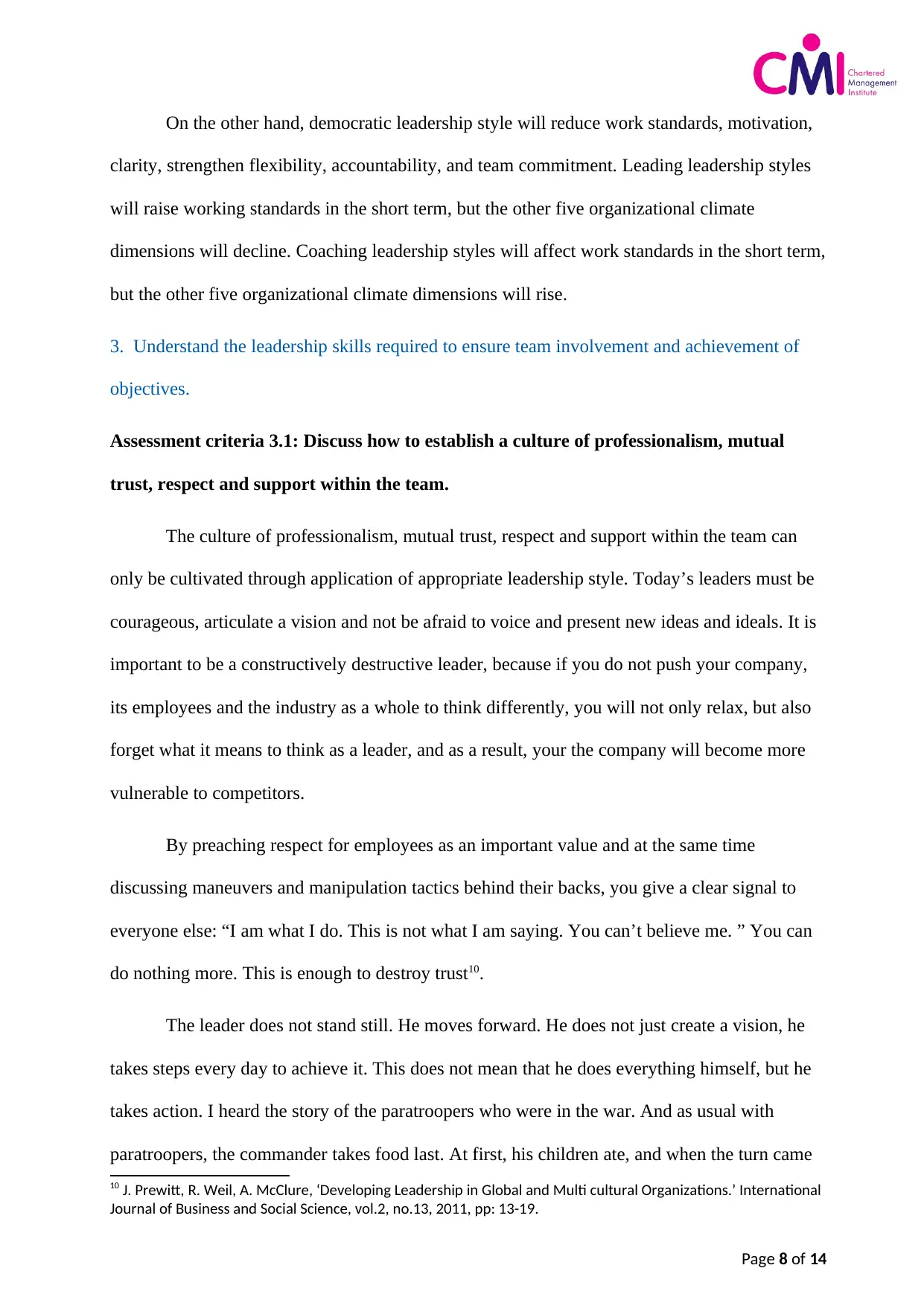
On the other hand, democratic leadership style will reduce work standards, motivation,
clarity, strengthen flexibility, accountability, and team commitment. Leading leadership styles
will raise working standards in the short term, but the other five organizational climate
dimensions will decline. Coaching leadership styles will affect work standards in the short term,
but the other five organizational climate dimensions will rise.
3. Understand the leadership skills required to ensure team involvement and achievement of
objectives.
Assessment criteria 3.1: Discuss how to establish a culture of professionalism, mutual
trust, respect and support within the team.
The culture of professionalism, mutual trust, respect and support within the team can
only be cultivated through application of appropriate leadership style. Today’s leaders must be
courageous, articulate a vision and not be afraid to voice and present new ideas and ideals. It is
important to be a constructively destructive leader, because if you do not push your company,
its employees and the industry as a whole to think differently, you will not only relax, but also
forget what it means to think as a leader, and as a result, your the company will become more
vulnerable to competitors.
By preaching respect for employees as an important value and at the same time
discussing maneuvers and manipulation tactics behind their backs, you give a clear signal to
everyone else: “I am what I do. This is not what I am saying. You can’t believe me. ” You can
do nothing more. This is enough to destroy trust10.
The leader does not stand still. He moves forward. He does not just create a vision, he
takes steps every day to achieve it. This does not mean that he does everything himself, but he
takes action. I heard the story of the paratroopers who were in the war. And as usual with
paratroopers, the commander takes food last. At first, his children ate, and when the turn came
10 J. Prewitt, R. Weil, A. McClure, ‘Developing Leadership in Global and Multi cultural Organizations.’ International
Journal of Business and Social Science, vol.2, no.13, 2011, pp: 13-19.
Page 8 of 14
clarity, strengthen flexibility, accountability, and team commitment. Leading leadership styles
will raise working standards in the short term, but the other five organizational climate
dimensions will decline. Coaching leadership styles will affect work standards in the short term,
but the other five organizational climate dimensions will rise.
3. Understand the leadership skills required to ensure team involvement and achievement of
objectives.
Assessment criteria 3.1: Discuss how to establish a culture of professionalism, mutual
trust, respect and support within the team.
The culture of professionalism, mutual trust, respect and support within the team can
only be cultivated through application of appropriate leadership style. Today’s leaders must be
courageous, articulate a vision and not be afraid to voice and present new ideas and ideals. It is
important to be a constructively destructive leader, because if you do not push your company,
its employees and the industry as a whole to think differently, you will not only relax, but also
forget what it means to think as a leader, and as a result, your the company will become more
vulnerable to competitors.
By preaching respect for employees as an important value and at the same time
discussing maneuvers and manipulation tactics behind their backs, you give a clear signal to
everyone else: “I am what I do. This is not what I am saying. You can’t believe me. ” You can
do nothing more. This is enough to destroy trust10.
The leader does not stand still. He moves forward. He does not just create a vision, he
takes steps every day to achieve it. This does not mean that he does everything himself, but he
takes action. I heard the story of the paratroopers who were in the war. And as usual with
paratroopers, the commander takes food last. At first, his children ate, and when the turn came
10 J. Prewitt, R. Weil, A. McClure, ‘Developing Leadership in Global and Multi cultural Organizations.’ International
Journal of Business and Social Science, vol.2, no.13, 2011, pp: 13-19.
Page 8 of 14
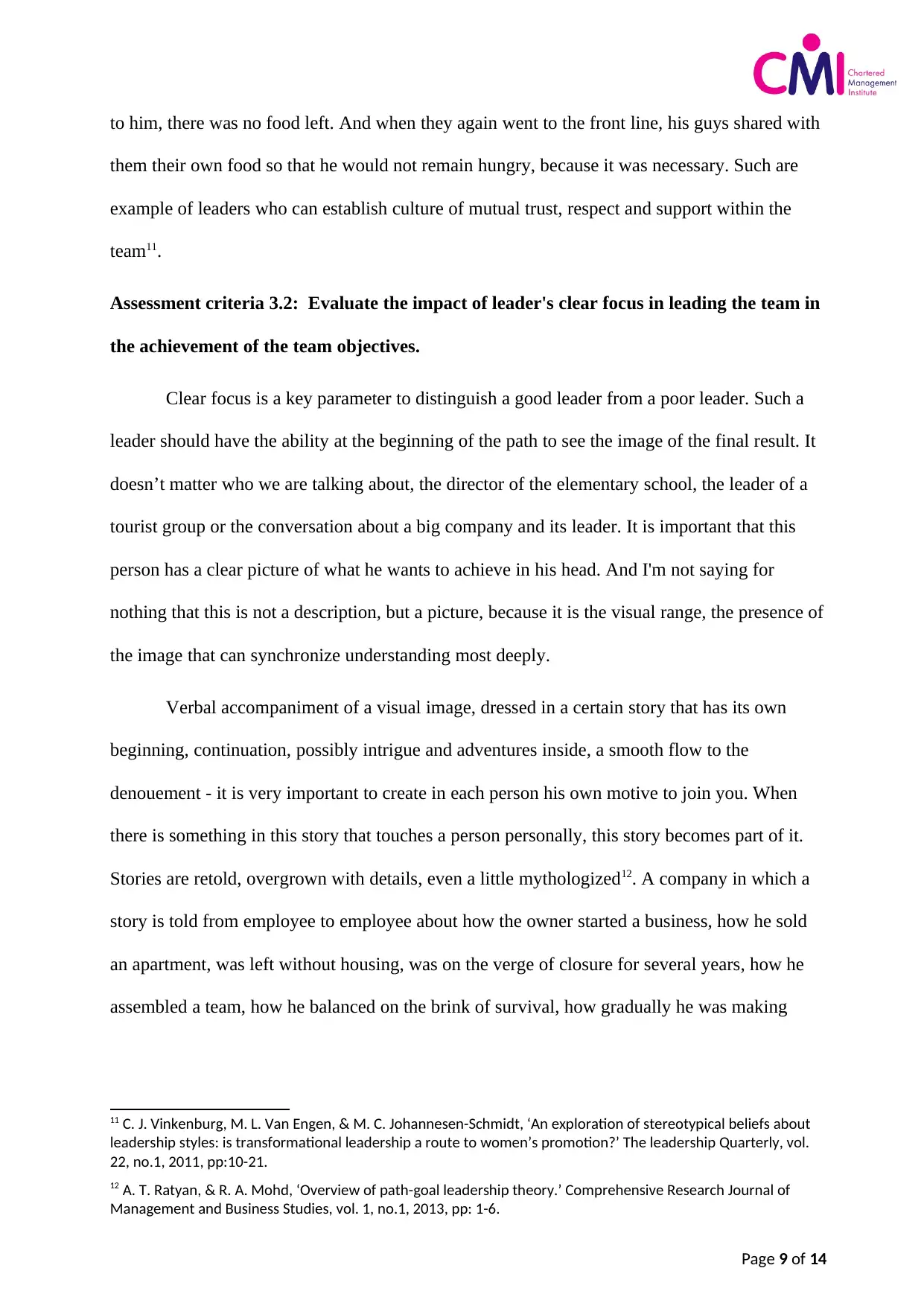
to him, there was no food left. And when they again went to the front line, his guys shared with
them their own food so that he would not remain hungry, because it was necessary. Such are
example of leaders who can establish culture of mutual trust, respect and support within the
team11.
Assessment criteria 3.2: Evaluate the impact of leader's clear focus in leading the team in
the achievement of the team objectives.
Clear focus is a key parameter to distinguish a good leader from a poor leader. Such a
leader should have the ability at the beginning of the path to see the image of the final result. It
doesn’t matter who we are talking about, the director of the elementary school, the leader of a
tourist group or the conversation about a big company and its leader. It is important that this
person has a clear picture of what he wants to achieve in his head. And I'm not saying for
nothing that this is not a description, but a picture, because it is the visual range, the presence of
the image that can synchronize understanding most deeply.
Verbal accompaniment of a visual image, dressed in a certain story that has its own
beginning, continuation, possibly intrigue and adventures inside, a smooth flow to the
denouement - it is very important to create in each person his own motive to join you. When
there is something in this story that touches a person personally, this story becomes part of it.
Stories are retold, overgrown with details, even a little mythologized12. A company in which a
story is told from employee to employee about how the owner started a business, how he sold
an apartment, was left without housing, was on the verge of closure for several years, how he
assembled a team, how he balanced on the brink of survival, how gradually he was making
11 C. J. Vinkenburg, M. L. Van Engen, & M. C. Johannesen-Schmidt, ‘An exploration of stereotypical beliefs about
leadership styles: is transformational leadership a route to women’s promotion?’ The leadership Quarterly, vol.
22, no.1, 2011, pp:10-21.
12 A. T. Ratyan, & R. A. Mohd, ‘Overview of path-goal leadership theory.’ Comprehensive Research Journal of
Management and Business Studies, vol. 1, no.1, 2013, pp: 1-6.
Page 9 of 14
them their own food so that he would not remain hungry, because it was necessary. Such are
example of leaders who can establish culture of mutual trust, respect and support within the
team11.
Assessment criteria 3.2: Evaluate the impact of leader's clear focus in leading the team in
the achievement of the team objectives.
Clear focus is a key parameter to distinguish a good leader from a poor leader. Such a
leader should have the ability at the beginning of the path to see the image of the final result. It
doesn’t matter who we are talking about, the director of the elementary school, the leader of a
tourist group or the conversation about a big company and its leader. It is important that this
person has a clear picture of what he wants to achieve in his head. And I'm not saying for
nothing that this is not a description, but a picture, because it is the visual range, the presence of
the image that can synchronize understanding most deeply.
Verbal accompaniment of a visual image, dressed in a certain story that has its own
beginning, continuation, possibly intrigue and adventures inside, a smooth flow to the
denouement - it is very important to create in each person his own motive to join you. When
there is something in this story that touches a person personally, this story becomes part of it.
Stories are retold, overgrown with details, even a little mythologized12. A company in which a
story is told from employee to employee about how the owner started a business, how he sold
an apartment, was left without housing, was on the verge of closure for several years, how he
assembled a team, how he balanced on the brink of survival, how gradually he was making
11 C. J. Vinkenburg, M. L. Van Engen, & M. C. Johannesen-Schmidt, ‘An exploration of stereotypical beliefs about
leadership styles: is transformational leadership a route to women’s promotion?’ The leadership Quarterly, vol.
22, no.1, 2011, pp:10-21.
12 A. T. Ratyan, & R. A. Mohd, ‘Overview of path-goal leadership theory.’ Comprehensive Research Journal of
Management and Business Studies, vol. 1, no.1, 2013, pp: 1-6.
Page 9 of 14
⊘ This is a preview!⊘
Do you want full access?
Subscribe today to unlock all pages.

Trusted by 1+ million students worldwide
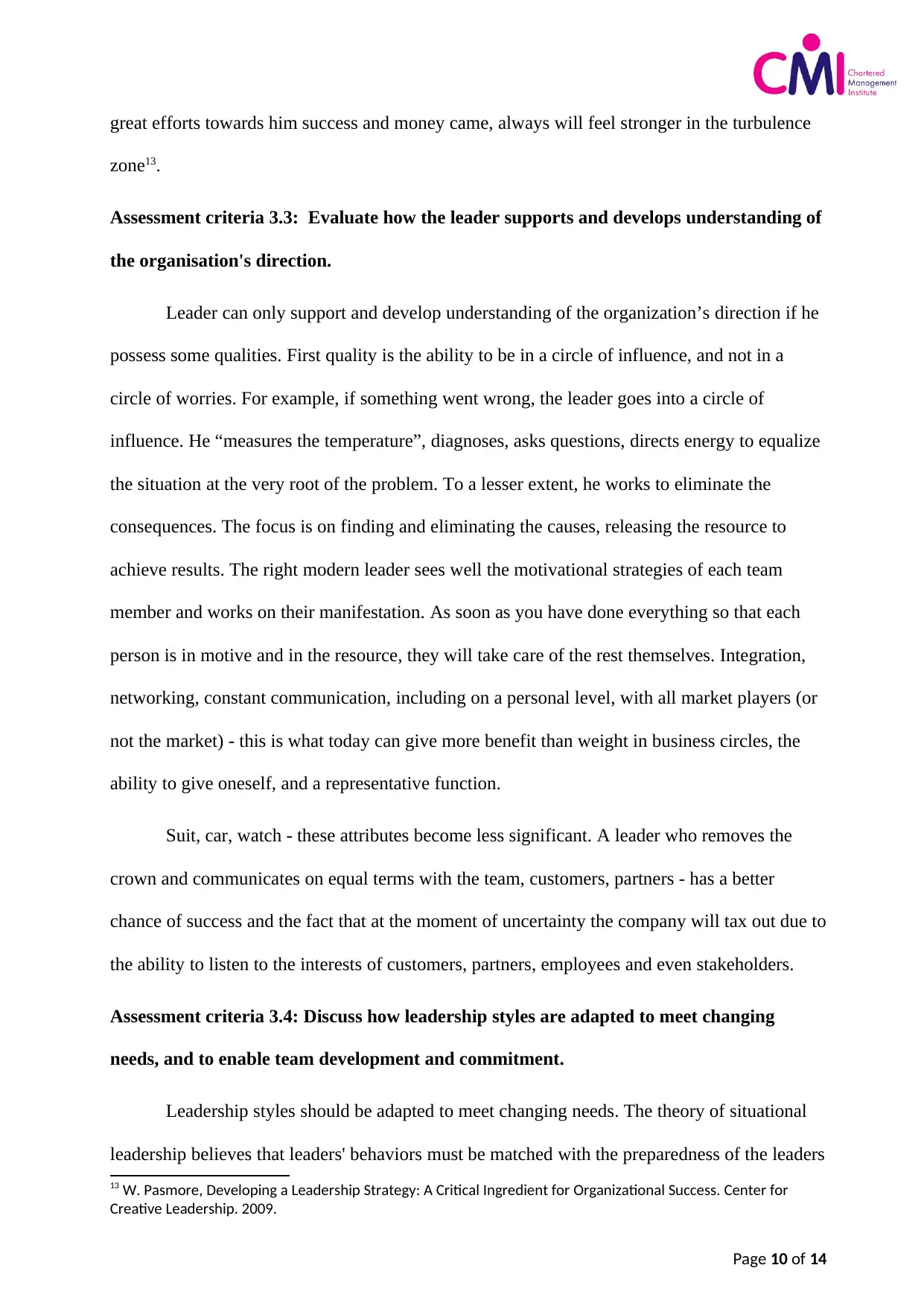
great efforts towards him success and money came, always will feel stronger in the turbulence
zone13.
Assessment criteria 3.3: Evaluate how the leader supports and develops understanding of
the organisation's direction.
Leader can only support and develop understanding of the organization’s direction if he
possess some qualities. First quality is the ability to be in a circle of influence, and not in a
circle of worries. For example, if something went wrong, the leader goes into a circle of
influence. He “measures the temperature”, diagnoses, asks questions, directs energy to equalize
the situation at the very root of the problem. To a lesser extent, he works to eliminate the
consequences. The focus is on finding and eliminating the causes, releasing the resource to
achieve results. The right modern leader sees well the motivational strategies of each team
member and works on their manifestation. As soon as you have done everything so that each
person is in motive and in the resource, they will take care of the rest themselves. Integration,
networking, constant communication, including on a personal level, with all market players (or
not the market) - this is what today can give more benefit than weight in business circles, the
ability to give oneself, and a representative function.
Suit, car, watch - these attributes become less significant. A leader who removes the
crown and communicates on equal terms with the team, customers, partners - has a better
chance of success and the fact that at the moment of uncertainty the company will tax out due to
the ability to listen to the interests of customers, partners, employees and even stakeholders.
Assessment criteria 3.4: Discuss how leadership styles are adapted to meet changing
needs, and to enable team development and commitment.
Leadership styles should be adapted to meet changing needs. The theory of situational
leadership believes that leaders' behaviors must be matched with the preparedness of the leaders
13 W. Pasmore, Developing a Leadership Strategy: A Critical Ingredient for Organizational Success. Center for
Creative Leadership. 2009.
Page 10 of 14
zone13.
Assessment criteria 3.3: Evaluate how the leader supports and develops understanding of
the organisation's direction.
Leader can only support and develop understanding of the organization’s direction if he
possess some qualities. First quality is the ability to be in a circle of influence, and not in a
circle of worries. For example, if something went wrong, the leader goes into a circle of
influence. He “measures the temperature”, diagnoses, asks questions, directs energy to equalize
the situation at the very root of the problem. To a lesser extent, he works to eliminate the
consequences. The focus is on finding and eliminating the causes, releasing the resource to
achieve results. The right modern leader sees well the motivational strategies of each team
member and works on their manifestation. As soon as you have done everything so that each
person is in motive and in the resource, they will take care of the rest themselves. Integration,
networking, constant communication, including on a personal level, with all market players (or
not the market) - this is what today can give more benefit than weight in business circles, the
ability to give oneself, and a representative function.
Suit, car, watch - these attributes become less significant. A leader who removes the
crown and communicates on equal terms with the team, customers, partners - has a better
chance of success and the fact that at the moment of uncertainty the company will tax out due to
the ability to listen to the interests of customers, partners, employees and even stakeholders.
Assessment criteria 3.4: Discuss how leadership styles are adapted to meet changing
needs, and to enable team development and commitment.
Leadership styles should be adapted to meet changing needs. The theory of situational
leadership believes that leaders' behaviors must be matched with the preparedness of the leaders
13 W. Pasmore, Developing a Leadership Strategy: A Critical Ingredient for Organizational Success. Center for
Creative Leadership. 2009.
Page 10 of 14
Paraphrase This Document
Need a fresh take? Get an instant paraphrase of this document with our AI Paraphraser
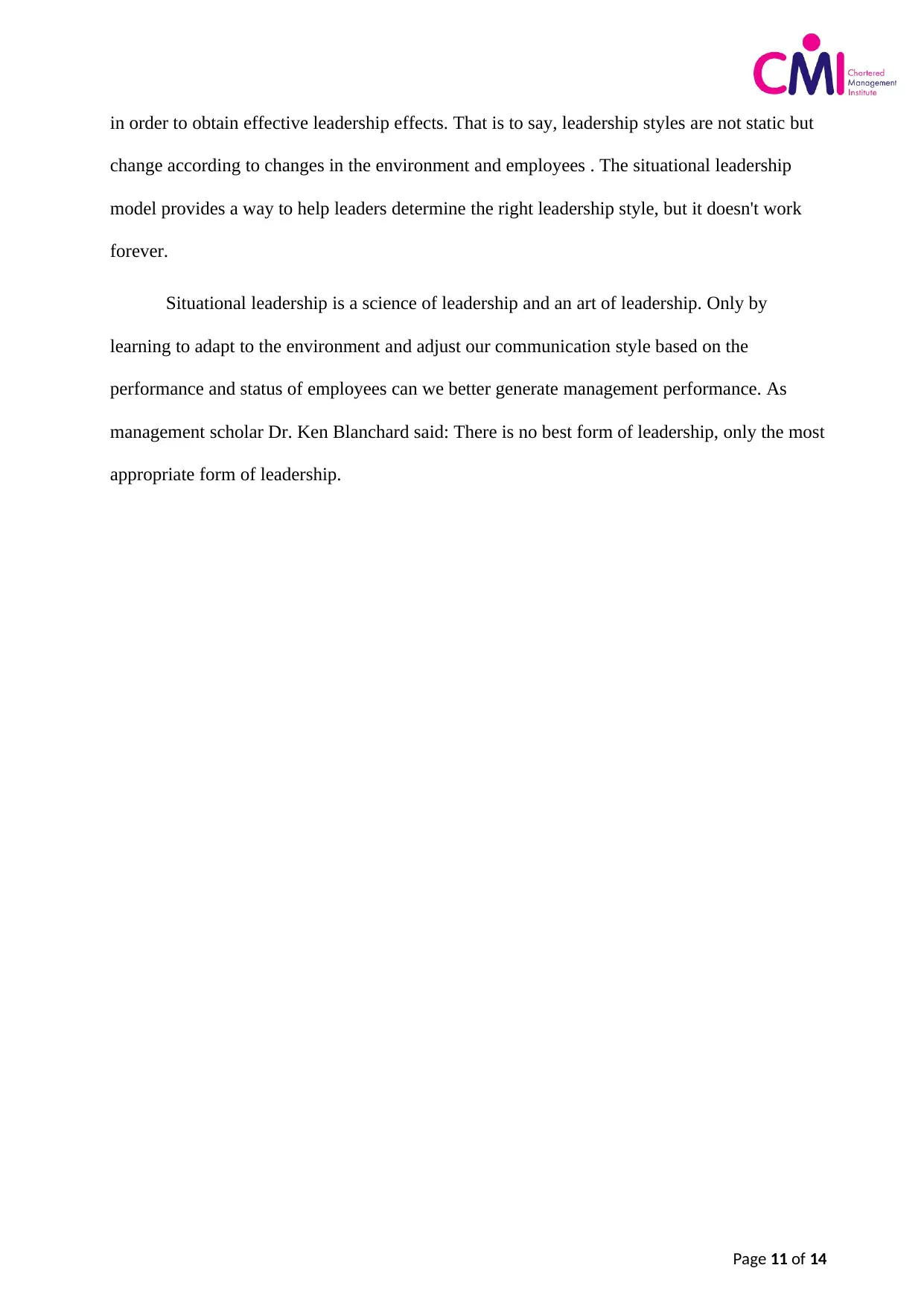
in order to obtain effective leadership effects. That is to say, leadership styles are not static but
change according to changes in the environment and employees . The situational leadership
model provides a way to help leaders determine the right leadership style, but it doesn't work
forever.
Situational leadership is a science of leadership and an art of leadership. Only by
learning to adapt to the environment and adjust our communication style based on the
performance and status of employees can we better generate management performance. As
management scholar Dr. Ken Blanchard said: There is no best form of leadership, only the most
appropriate form of leadership.
Page 11 of 14
change according to changes in the environment and employees . The situational leadership
model provides a way to help leaders determine the right leadership style, but it doesn't work
forever.
Situational leadership is a science of leadership and an art of leadership. Only by
learning to adapt to the environment and adjust our communication style based on the
performance and status of employees can we better generate management performance. As
management scholar Dr. Ken Blanchard said: There is no best form of leadership, only the most
appropriate form of leadership.
Page 11 of 14
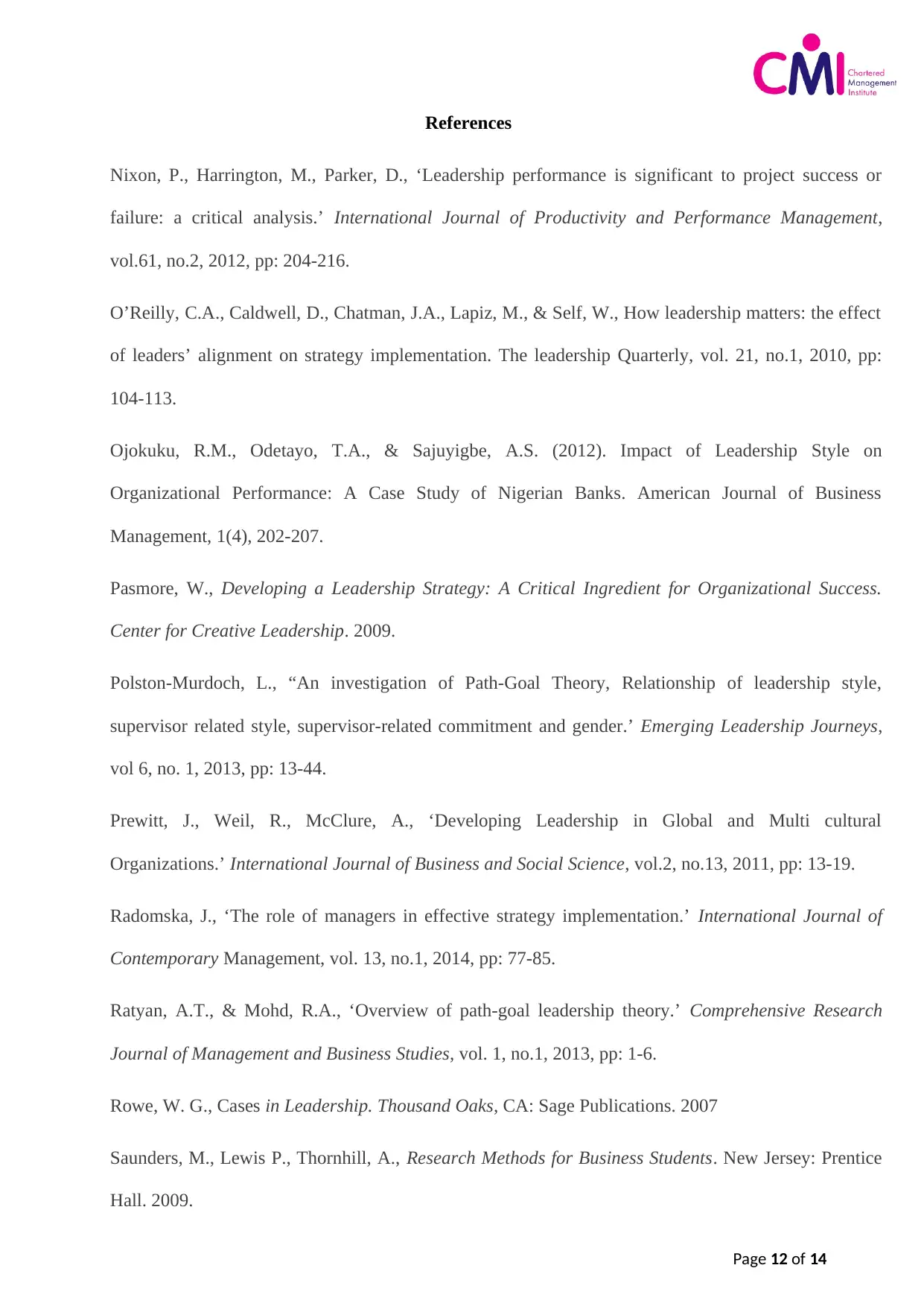
References
Nixon, P., Harrington, M., Parker, D., ‘Leadership performance is significant to project success or
failure: a critical analysis.’ International Journal of Productivity and Performance Management,
vol.61, no.2, 2012, pp: 204-216.
O’Reilly, C.A., Caldwell, D., Chatman, J.A., Lapiz, M., & Self, W., How leadership matters: the effect
of leaders’ alignment on strategy implementation. The leadership Quarterly, vol. 21, no.1, 2010, pp:
104-113.
Ojokuku, R.M., Odetayo, T.A., & Sajuyigbe, A.S. (2012). Impact of Leadership Style on
Organizational Performance: A Case Study of Nigerian Banks. American Journal of Business
Management, 1(4), 202-207.
Pasmore, W., Developing a Leadership Strategy: A Critical Ingredient for Organizational Success.
Center for Creative Leadership. 2009.
Polston-Murdoch, L., “An investigation of Path-Goal Theory, Relationship of leadership style,
supervisor related style, supervisor-related commitment and gender.’ Emerging Leadership Journeys,
vol 6, no. 1, 2013, pp: 13-44.
Prewitt, J., Weil, R., McClure, A., ‘Developing Leadership in Global and Multi cultural
Organizations.’ International Journal of Business and Social Science, vol.2, no.13, 2011, pp: 13-19.
Radomska, J., ‘The role of managers in effective strategy implementation.’ International Journal of
Contemporary Management, vol. 13, no.1, 2014, pp: 77-85.
Ratyan, A.T., & Mohd, R.A., ‘Overview of path-goal leadership theory.’ Comprehensive Research
Journal of Management and Business Studies, vol. 1, no.1, 2013, pp: 1-6.
Rowe, W. G., Cases in Leadership. Thousand Oaks, CA: Sage Publications. 2007
Saunders, M., Lewis P., Thornhill, A., Research Methods for Business Students. New Jersey: Prentice
Hall. 2009.
Page 12 of 14
Nixon, P., Harrington, M., Parker, D., ‘Leadership performance is significant to project success or
failure: a critical analysis.’ International Journal of Productivity and Performance Management,
vol.61, no.2, 2012, pp: 204-216.
O’Reilly, C.A., Caldwell, D., Chatman, J.A., Lapiz, M., & Self, W., How leadership matters: the effect
of leaders’ alignment on strategy implementation. The leadership Quarterly, vol. 21, no.1, 2010, pp:
104-113.
Ojokuku, R.M., Odetayo, T.A., & Sajuyigbe, A.S. (2012). Impact of Leadership Style on
Organizational Performance: A Case Study of Nigerian Banks. American Journal of Business
Management, 1(4), 202-207.
Pasmore, W., Developing a Leadership Strategy: A Critical Ingredient for Organizational Success.
Center for Creative Leadership. 2009.
Polston-Murdoch, L., “An investigation of Path-Goal Theory, Relationship of leadership style,
supervisor related style, supervisor-related commitment and gender.’ Emerging Leadership Journeys,
vol 6, no. 1, 2013, pp: 13-44.
Prewitt, J., Weil, R., McClure, A., ‘Developing Leadership in Global and Multi cultural
Organizations.’ International Journal of Business and Social Science, vol.2, no.13, 2011, pp: 13-19.
Radomska, J., ‘The role of managers in effective strategy implementation.’ International Journal of
Contemporary Management, vol. 13, no.1, 2014, pp: 77-85.
Ratyan, A.T., & Mohd, R.A., ‘Overview of path-goal leadership theory.’ Comprehensive Research
Journal of Management and Business Studies, vol. 1, no.1, 2013, pp: 1-6.
Rowe, W. G., Cases in Leadership. Thousand Oaks, CA: Sage Publications. 2007
Saunders, M., Lewis P., Thornhill, A., Research Methods for Business Students. New Jersey: Prentice
Hall. 2009.
Page 12 of 14
⊘ This is a preview!⊘
Do you want full access?
Subscribe today to unlock all pages.

Trusted by 1+ million students worldwide
1 out of 14
Related Documents
Your All-in-One AI-Powered Toolkit for Academic Success.
+13062052269
info@desklib.com
Available 24*7 on WhatsApp / Email
![[object Object]](/_next/static/media/star-bottom.7253800d.svg)
Unlock your academic potential
Copyright © 2020–2025 A2Z Services. All Rights Reserved. Developed and managed by ZUCOL.





